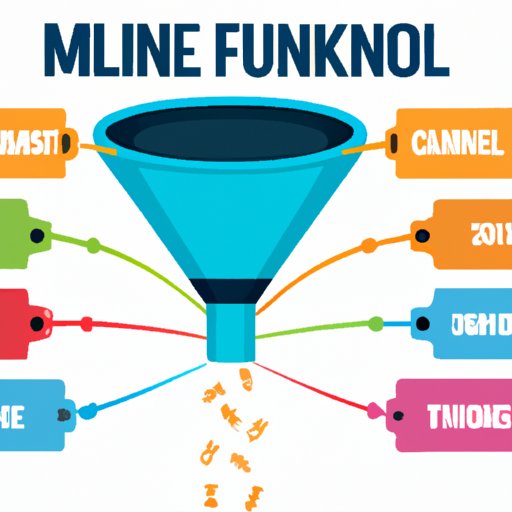The Ultimate Guide to Understanding and Optimizing Your Marketing Funnel
As a business owner, you’re always looking for ways to drive leads and increase conversions. The marketing funnel is one of the most critical aspects of achieving these goals, but it can be tough to know where to start. In this guide, we’ll take you through everything you need to know about the marketing funnel, how to optimize each stage, common mistakes to avoid, and how to integrate your sales funnel into your overall strategy.
Section 1: The Basics of Marketing Funnels
A marketing funnel is a concept that illustrates the journey potential customers take to become actual customers. It’s called a ‘funnel’ because it is wider at the top than at the bottom.
The marketing funnel consists of three main stages:
- Awareness: The customer discovers your product or service. This stage is crucial for building brand awareness and attracting leads.
- Consideration: The customer begins to evaluate whether your product or service is right for them. This stage is crucial for building trust and nurturing leads.
- Decision: The customer decides to make a purchase and become a customer. This stage is crucial for conversions and retention.
It’s important to note that the marketing funnel isn’t a one-size-fits-all solution. Instead, you should tailor your funnel to fit your specific business and industry. Here are a few examples of how different businesses might structure their marketing funnels:
- E-commerce store: Awareness might involve social media ads, consideration might involve retargeted ads or email campaigns, and decision might involve offering discounts to first-time customers.
- Service-based business: Awareness might involve hosting webinars, consideration might involve offering free consultations, and decision might involve offering tiered pricing options.
Section 2: Optimizing Your Marketing Funnel
The key to a successful marketing funnel is optimizing each stage. Here are some tips for optimizing each stage of the funnel:
Top of the funnel
The top of the funnel is all about building brand awareness and attracting leads. Here are some tips for optimizing this stage:
- Create effective lead magnets: A lead magnet is a free resource you offer in exchange for a customer’s contact information. This could be anything from an e-book to a free trial. Make sure your lead magnet is valuable enough to get people to sign up.
- Invest in paid advertising: Paid advertising can help you get your product or service in front of a wider audience. Consider using social media ads or Google Ads.
Middle of the funnel
The middle of the funnel is all about nurturing your leads and building trust. Here are some tips for optimizing this stage:
- Personalize your communication: Use tools like email marketing automation to send personalized messages to your leads based on their behaviors and interests.
- Share case studies and testimonials: Social proof is a powerful tool for building trust. Share examples of how other customers have benefited from your product or service.
Bottom of the funnel
The bottom of the funnel is all about closing sales. Here are some tips for optimizing this stage:
- Make the buying process as simple as possible: Streamline the checkout process and provide easy payment options.
- Offer tiered pricing options: Providing different pricing tiers based on customer needs can help you close more sales.
Section 3: Common Marketing Funnel Mistakes
Building and implementing a successful marketing funnel can be challenging, but there are some common mistakes that businesses should avoid:
- Not tailoring the funnel to their specific industry and audience
- Not measuring and analyzing key metrics like conversion rates and customer lifetime value
- Not optimizing each stage of the funnel
- Not providing enough value in their lead magnets or not following up with leads effectively
To avoid these mistakes, it’s important to have a thorough understanding of your audience, regularly review your funnel’s metrics, and consistently optimize each stage of the funnel.
Section 4: Marketing Funnels vs. Sales Funnels
While the marketing funnel is all about building awareness and nurturing leads, the sales funnel is all about closing the deal. Here are some key differences between marketing and sales funnels:
- Marketing funnels focus on building brand awareness and attracting leads, while sales funnels focus on closing those leads into customers.
- Marketing funnels tend to be longer and more drawn out, while sales funnels are more focused and direct.
It’s important to integrate your marketing and sales funnels to ensure a seamless customer journey. By using the data from your marketing funnel to personalize your sales funnel, you can increase your chances of successfully closing leads into customers.
Conclusion
A marketing funnel is a powerful tool for driving leads and increasing conversions. By understanding the three stages of the funnel, optimizing each stage, avoiding common mistakes, and integrating your sales funnel, you can create an effective funnel for your business.
Remember to tailor your funnel to your specific industry and audience, measure key metrics, and consistently optimize each stage of the funnel. By implementing the tips and strategies discussed in this guide, you can create a successful marketing funnel that will help you achieve your business goals.
